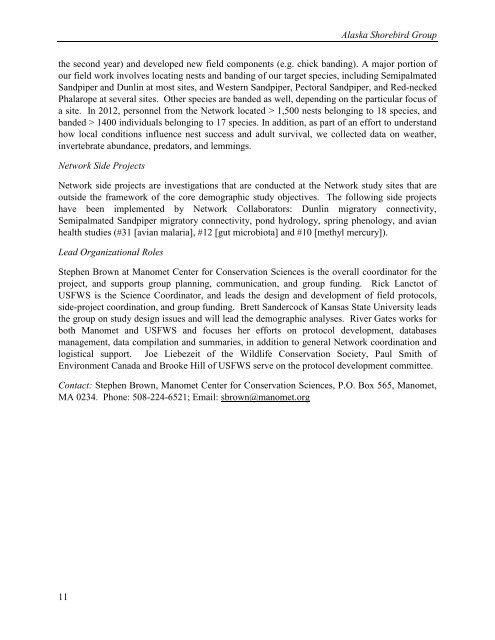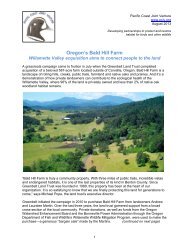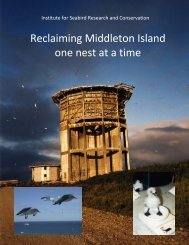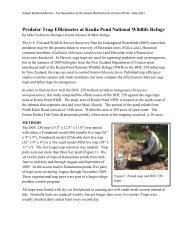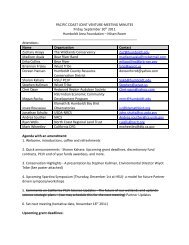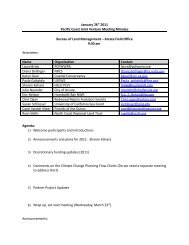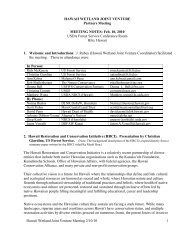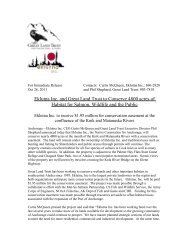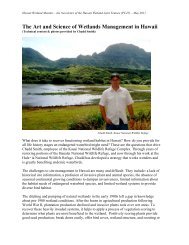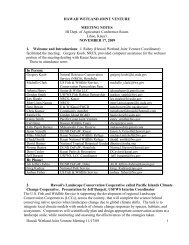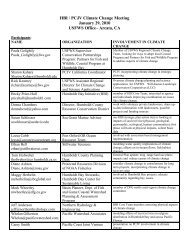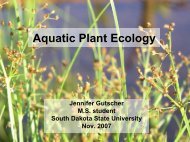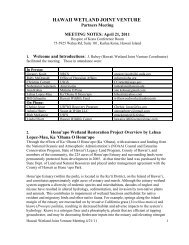<strong>Alaska</strong> <strong>Shorebird</strong> <strong>Group</strong>#4 ARCTIC SHOREBIRD DEMOGRAPHICS NETWORK:OVERVIEWINVESTIGATORS: STEPHEN BROWN, MANOMET CENTER FORCONSERVATION SCIENCE, RICK LANCTOT, U.S. FISH AND WILDLIFESERVICE, BRETT SANDERCOCK, KANSAS STATE UNIVERSITY AND RIVERGATES, U.S. FISH AND WILDLIFE AND MANOMET CENTER FORCONSERVATION SCIENCES.Project Goals and ApproachRecent shorebird trend analyses indicate that many North American shorebird species aredeclining, but we do not know why. The overall goal of the Arctic <strong>Shorebird</strong> DemographicsNetwork (Network) is to conduct demographic analyses for several target species that will helpdetermine factors limiting population size. The Network measures demographic rates such asadult and juvenile survival, productivity, and other demographic parameters at various lifehistory stages. In addition, the power of the Network will substantially increase our ability toaddress a wide variety of other science and conservation goals that can only be studied at aregional or global level, such as migratory connectivity studies that require work across theentire range of a species. Multiple study years are needed to accurately measure survivorship ofmarked individuals, and also because significant year to year variation occurs in the demographicrates of shorebirds. We anticipate that the Network will provide data critical to conservationplanning for shorebirds through its planned completion in 2015.Network CollaboratorsThe Network involves participation of collaborators from federal and state/provincial agencies(USFWS, USGS, Environment Canada, Ontario Ministry of Natural Resources), academicinstitutions (University of <strong>Alaska</strong> Fairbanks, Cornell Lab of Ornithology, Kansas StateUniversity, Simon Fraser University, Mount Allison University, University of Florida, MoscowState University, Lomonosov, University of Quebec, Rimouski and Trent University) and nonprofitorganizations (Manomet Inc., Wildlife Conservation Society). All are actively conductingArctic shorebird research and can implement similar protocols at their study sites. In addition,the Network relies on partners across the range of the target species for resighting efforts ofbanded birds. Current participants include 15 breeding season study sites spanning the entire<strong>Alaska</strong>n (n = 7), Canadian Arctic (n = 5) and Russian Arctic (n = 2, Fig. 1). Project summariesare available for the following <strong>Alaska</strong> sites: Nome (#9, 17), Cape Krusenstern (# 11), Barrow(#18), the Ikpikpuk River (# 20), and Prudhoe Bay (# 19). Sites in Canada include MackenzieDelta, Bylot Island, East Bay and Burntpoint Creek (new in 2012). Sites is Russia includeChaun Delta and Lower Khatanga River both new in 2012.Third Year Completed2012 marked the third year (of 5 years) where data were collected in the field. In preparation forthis work, the protocol subcommittee revised the 2011 field protocols (based on feedback from10
<strong>Alaska</strong> <strong>Shorebird</strong> <strong>Group</strong>the second year) and developed new field components (e.g. chick banding). A major portion ofour field work involves locating nests and banding of our target species, including SemipalmatedSandpiper and Dunlin at most sites, and Western Sandpiper, Pectoral Sandpiper, and Red-neckedPhalarope at several sites. Other species are banded as well, depending on the particular focus ofa site. In 2012, personnel from the Network located > 1,500 nests belonging to 18 species, andbanded > 1400 individuals belonging to 17 species. In addition, as part of an effort to understandhow local conditions influence nest success and adult survival, we collected data on weather,invertebrate abundance, predators, and lemmings.Network Side ProjectsNetwork side projects are investigations that are conducted at the Network study sites that areoutside the framework of the core demographic study objectives. The following side projectshave been implemented by Network Collaborators: Dunlin migratory connectivity,Semipalmated Sandpiper migratory connectivity, pond hydrology, spring phenology, and avianhealth studies (#31 [avian malaria], #12 [gut microbiota] and #10 [methyl mercury]).Lead Organizational RolesStephen Brown at Manomet Center for Conservation Sciences is the overall coordinator for theproject, and supports group planning, communication, and group funding. Rick Lanctot ofUSFWS is the Science Coordinator, and leads the design and development of field protocols,side-project coordination, and group funding. Brett Sandercock of Kansas State University leadsthe group on study design issues and will lead the demographic analyses. River Gates works forboth Manomet and USFWS and focuses her efforts on protocol development, databasesmanagement, data compilation and summaries, in addition to general Network coordination andlogistical support. Joe Liebezeit of the Wildlife Conservation Society, Paul Smith ofEnvironment Canada and Brooke Hill of USFWS serve on the protocol development committee.Contact: Stephen Brown, Manomet Center for Conservation Sciences, P.O. Box 565, Manomet,MA 0234. Phone: 508-224-6521; Email: sbrown@manomet.org11


